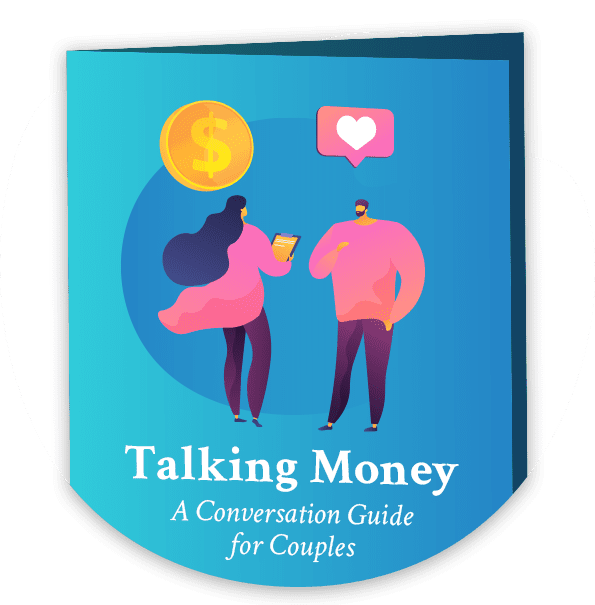Warning: This article contains spoilers for Season 14 of the Lifetime series “Married at First Sight,” which is now streaming on Netflix.
Rounding out the recent barrage of “social experiment”-style reality TV shows is “Married at First Sight,” the Lifetime series going 17 seasons strong with another on the way.
It can feel like many of these shows bleed into one another, but “Married at First Sight” grabbed me for one reason: the miscommunications are so blatant and resolvable that I literally scream at the screen.
Specifically, the couples are missing a critical piece of relational success: recognizing and honoring each other’s love languages.
Let’s dive into the show’s background before analyzing the interplay of love languages and marital happiness.
BEFORE getting married, what conversations about MONEY should you have with your partner?
Use this guide to discuss budgets, assets, debts, goals, joints bank accounts and more.
Get the guide
“Married at First Sight”: Exactly What It Sounds Like

“Married at First Sight” toys with the theory that a marriage can be built on objective compatibility alone.
A team of relationship experts, including psychologists, sociologists, and relationship counselors, play matchmaker with a pool of candidates based on their characteristics, ideologies, and hopes and dreams for their future.
They analyze the participants using in-depth interviews, personality tests, and background checks to evaluate each person’s values, beliefs, and relationship goals.
Once the matches are made, the couples meet for the first time at the altar (yes, they legally marry), beginning an experiment to see if they can build a lasting relationship starting from marriage.
The show then follows the newlyweds through their honeymoon and subsequent daily lives, documenting their experiences and challenges. At the end of the season, each couple decides if they’ll stay married.
The process explores whether expertly matched individuals can develop into successful, long-lasting partnerships (spoiler alert: they frequently cannot).
What’s Love Languages Got To Do With It?

So, what’s love languages got to do with it?
Everything.
For those unfamiliar, the premise is simple: people give and receive love differently based on their personalities.
There are five primary love languages as described in the book “The 5 Love Languages” by Gary Chapman, including:
- Acts of Service
- Giving & Receiving Gifts
- Quality Time
- Words of Affirmation
- Physical Touch
Most people communicate with each love language to some degree, but you may identify with one or two.
The tricky part of love languages is recognizing your partner might not want or need love like you do.
It’s common, if not the norm, to have completely different love languages than your partner.
The key is to maintain an open line of communication about your love languages and how this impacts your personal needs in the relationship.
Recognizing and honoring each other’s love languages takes time and practice—neither of which are abundant in the whirlwind marriages of “Married at First Sight.”
Let’s explore how love languages played out in real-time for our four Season 14 couples.
Lindsey & Mark

What a trainwreck.
Lindsey, self-described as “a lot,” comes in hot with her personality from the beginning.
While she presents as overbearing or smothering, it’s apparent this reflects how she gives and receives love through a combination of Acts of Service, Quality Time, and Words of Affirmation.
For Lindsey, spending time together—even if it’s excessive—-is her preferred way of forging a connection. Similarly, she’s inclined to show affection through actions, such as when she proactively cleaned Mark’s pest-infested apartment.
Unfortunately, Mark requires space to let his love develop. This, combined with his inability to express gratitude or affection verbally, spirals into a cycle of miscommunication and arguments.
Again, having different love languages is entirely normal. But if you’re not openly discussing them, you’ll never be able to recognize the full impact of your actions on your partner’s feelings.
In the end, Lindsey & Mark decide to stay married, though they don’t seem to reach any particular milestones in their communication.
Katina & Olajuwon

Did anyone else find themselves cringing through every one of Katina and Olajuwon’s interactions?
While these two exhibited more physical chemistry than some of the others, one recurring argument sent me to the brink.
Olajuwon has specific requirements for a wife, AKA cooking and cleaning.
We can call it Acts of Service (or misogyny), but either way, this is the primary way Olajuwon receives love in his relationships.
However, instead of expressing that he feels love when he receives Acts of Service, it just keeps reiterating that he expects his wife to clean the house and cook for him. If he had just expressed that this is the way he experiences love, they could have avoided many of their arguments, and in turn, Katina may have understood his desires rather than being offended by them.
The problem is Katina isn’t exactly a homemaker. Fortunately, she’s willing to learn, and this becomes a primary plot point of their relationship as their early marriage days transpire.
To their credit, they maintain consistent communication about this expectation, and Olajuwon responds positively to Katina’s efforts. The two ultimately decide to stay married, knowing they must continue trying to match each other’s love languages.
Noi & Steve

Like Katina and Olajuwon, household duties and Acts of Service shape many of Steve and Noi’s conversations.
Since Steve is unemployed, Noi argues he should be solely responsible for household chores. For her, this form of Acts of Service is the most effective way for him to contribute to the relationship and how she’ll feel most appreciated as a full-time worker.
On the other hand, Steve is more inclined to show his love through gifts and other physical gestures, which is not what Noi was looking for.
When one person provides love in a way that they think will be appreciated, but their partner has a totally different love language and, therefore, doesn’t “feel the love” coming to them, both partners are set up for disappointment and resentment.
Steve and Noi never really get to the “why” of their arguments, but on the whole, they end the show with a reasonably strong relationship.
It may take years of feeling one another out to truly understand what each other needs—something that’s completely normal in marriage and relationships.
Jasmina & Michael

When it comes to Jasmina and Michael, it’s all things Physical Touch…or the lack thereof.
To clarify, Physical Touch extends beyond the intimacy of sex. It encompasses all touch, from hugging to holding hands to a simple knee squeeze.
Jasmina and Michael experience a lot of miscommunication, making it difficult for Jasmina to trust Michael with Physical Touch on most levels. However, by the end of the show, it’s clear that Michael’s first love language is Physical Touch, and since Jasmina is not able to provide for that need, it is something Michael had to consider in deciding whether to stay married or not.
While the two agree to stay married, there’s a bit of a cliffhanger as they consider what will be necessary to overcome the lack of intimacy in their relationship.
Love Takes Time

You can spend years with someone, and playing to their love language will still be an effort. The important part is recognizing your differences and making the effort in the first place. The first step is to determine what your love language is, and then communicate that to your partner so that they know how you receive love in the best way possible.
In “Married at First Sight,” time is not on the side of these couples as they’re virtually strangers.
Does it mean every match-made marriage is doomed? Not necessarily.
But it does mean each couple should bring awareness and care to the person they’re paired with while recognizing that meeting each other halfway in their love language is a lifelong journey.
